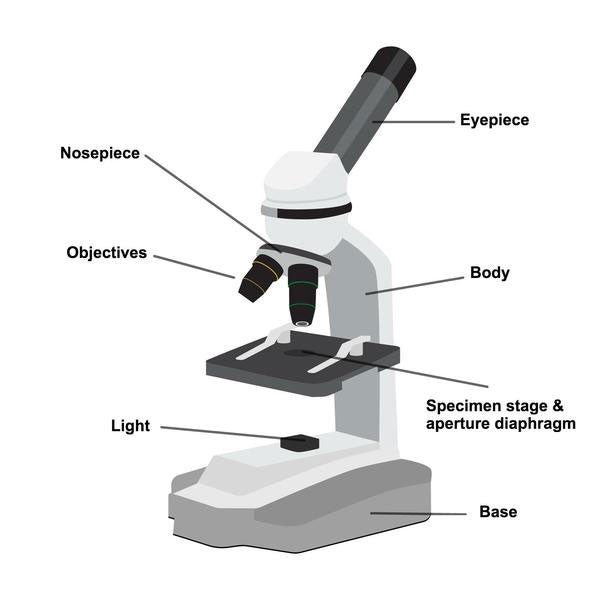Microscope Buyer's Guide

Microscopes are fantastic pieces of optical equipment that can open up a whole new world of discoveries. Whether you’re looking for a microscope to homeschool your child, support you in your job as a biologist or technician, or simply to fulfil your desire to learn about the world around you, there is a microscope that will suit your needs.
Choosing a microscope however, can be a confusing business so we’ve written this handy guide to help you understand how to pick the best one for your application. Buy first, lets take a quick look at the parts that make up a microscope and how they work together.
Parts of a microscope:

Eyepiece, objectives and the nosepiece
- You look through the eyepiece to observe your specimen
- Eyepieces have a set magnification that is often 10x
- Objective lenses sit on the end of a rotating nosepiece, are closest to your specimen and come in a range of magnifications
- Turning the nosepiece allows you to change objective lens
- Most microscopes will have several objective lenses in varying magnifications for example 10x, 40x and 100x
- The overall magnifications that the microscope can achieve are dependant on the objective lenses and the eyepiece working together - the magnification of the eyepiece multiplied by the magnification of the objective being used gives you the total magnification that you’re observing at. For example a 10x eyepiece looking through the objectives mentioned above would yield 100x, 400x, and 1,000x magnifications.
Microscope head
- Microscope heads come in a few main configurations
- Monocular heads have one eyepiece where you hold one eye closed. Some models have a rotating monocular so you can share your view with others
- Binocular heads have two eyepieces and often have a diopter adjustment allowing you to focus the microscope precisely
- Trinocular are less common, but have three eyepieces (a binocular and a monocular), so that you can share your views with others or attach a camera
Microscope light
- In order to see specimens properly, they need to be lit
- Modern, quality microscopes are generally lit with LED’s or halogen bulbs
- Compound microscopes generally have one light below the specimen stage, which illuminates the specimen from below. Some have an additional reflective light which shines down on to the specimen stage allowing you to observe opaque objects too
- Stereo microscopes have a reflective light that illuminates opaque specimens from above
- Some models allow you to adjust the brightness of the LEDs
Specimen stage
- Specimens are placed here for observation
- A hole in the middle of the stage allows the light to pass through the specimen. Higher end models allow you to adjust the size of this whole, or aperture diaphragm as it is known, to increase or decrease the amount of light that can pass through. Depending on the model and quality, this aperture diaphragm may have a simple design or a more complex design called an Iris Diaphragm
- Larger stages are better as they allow for the inspection of small and large specimens
- Higher end models allow the smooth movement of the stage, forward, back, left and right with smooth controls so that accurate inspection can be made
- Some models include a measurement ruler
Microscope body
- Look for a metal body that feels strong and sturdy for steady viewing
What type of microscope do I need?
When it comes to choosing a microscope for yourself or your child the most important question to ask yourself is what you plan to use it for. This will help you to decide which design will be most appropriate.
Are you wanting to view the internal structures of plant cells, blood cells or other biological specimens? If so, then regardless if you’re a high school student, hobbies or professional, you’ll need a high power compound microscope.
Or maybe you’re wanting to inspect larger specimens such as fossils, bugs, coins or circuit boards? In these situations you’ll be more suited to a lower magnification stereo microscope.
Lets look more closely at the types of microscopes.
Compound microscopes
When most people think of microscopes, they think of compound microscopes which are typically used by scientists. Compound microscopes have high magnifications often ranging from 40x up to 1000x and occasionally over. They are fantastic pieces of equipment for biological observations of specimens, with the high magnifications allowing you to inspect the internal structures of plant, blood, bone marrow cells and more. Compound microscopes can only be used to inspect transparent specimens that are mounted on slides, and produce 2D images that are reversed and upside down.
Compound microscopes are used in laboratories right through to high school classrooms and peoples homes. Indeed, they are a perfect option for beginners right though to experts, as they open up a whole new world that’s not visible to the naked eye. Most people with an interest in microorganisms and biology will be best suited to a compound microscope, as you’ll need a magnification of 400x or more to view these tiny organisms, so a lower powered stereo microscope may not suffice.
Compound microscopes are not suitable for inspecting large opaque subjects such as whole insects or rocks as most are only built with a transmitting light that requires specimens to be mounted on translucent slides for inspection. Some models do however also include a transmitting light which shines down on specimens and allows the observation and inspection of more opaque subjects, however if you’re wanting to observe larger objects such as coins, notes, stamps ect on a regular basis then a compound microscope probably isn’t the right option for you.
Types of compound microscope
Compound microscopes can vary in their magnification, quality and included features. If you’re a beginner, then a compound microscope with up to 400x magnification will be a great option. When choosing your microscope you may want to consider choosing a model that has fine and coarse focusing knobs for more precise focusing, an included reflective light incase you want to view the occasional small opaque subject, and a specimen stage that is easy to move small increments. All of these added features will make your viewing experience more enjoyable.
Stereo microscopes
Stereo microscopes have lower magnifications often ranging from 10x-40x and are ideal for getting a closer view of larger objects such as insects wings, flower petals, leaves, coins, miniature figurines, coins and more. They are often used by technical professionals carrying out intricate repairs on circuit boards, by biologists completing dissections, and can also be good for teaching small children; who may not understand the concepts of internal cell structures, or have the patience to prepare inspection slides, how to use a microscope. Having said that, children of school age will gain more enjoyment and educational value from a compound magnification, so if you’re trying to choose a microscope for your classroom or homeschooling, then a compound model would be a better option.
Digital microscopes
An increasing number of digital microscopes are becoming available, opening up world of sharing and saving microscopic images and videos. Many digital microscopes hook straight up to your computer or laptop, allowing you to see large, detailed views right on your screen. This is a fantastic way to share the experience with colleagues or your children, and to document your findings digitally for a later date. Some portable digital microscopes can be connected to a stand or used in a hand held manner which makes them ideal for viewing subjects that are too large to fit between the objective lens and the specimen stage on a traditional microscope.
Pocket microscopes
Pocket microscopes are great as gifts for children and have the benefit of being extremely portable. Pocket microscopes typically have very low magnifications and whilst they don’t offer a substitute for higher quality table top microscopes, they can open up a whole range of viewing opportunities whilst on the move.
Now we have taken a look at the options, lets summarise:
Buy a compound microscope for:
- High magnification observations of cells as a hobby, for study or your profession
- Home schooling where biological observations are on the agenda
Buy a stereo microscope for:
- Technical work that requires low magnification views of large subjects that won’t fit between the objective and the specimen stage on a compound microscope
- Inspection of coins, stamps and other items as a hobby or professionally
- For use with very young children
Buy a digital microscope for:
- Taking microscopic photos or videos for school projects or reports
- Sharing the viewing experience more easily with class mates, colleagues, family and friends
- Portable viewing
Buy a pocket microscope for:
- Children who want an inexpensive piece of equipment for inspections wherever they are
- Viewing artefacts on the move when full size equipment isn’t available
We hope you now have a better idea of the microscope that will suit your needs. Browse our range to find your new microscope, and don’t hesitate to contact us if you need any further support.










